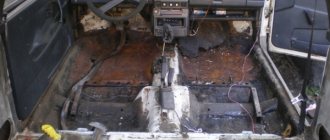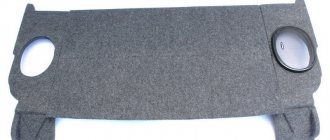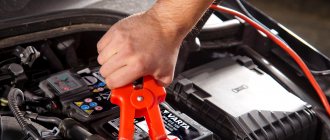Hello dear readers of the kuzov.info blog!
This review article will tell you about the types of car waxes, their application, advantages and disadvantages.
There are hundreds of wax-based products available today. They can be divided into the following categories:
- Liquid waxes
- Waxes in paste form
- Wax sprays
- Sealants for body protection (sealants)
For some car enthusiasts, waxing a car is a huge pleasure. Thus, they seem to achieve perfection in the appearance of the car. They are ready to polish the body every day. Such people are willing to spend a lot of time waxing, using products that are applied in several stages.
For other people who value their time very much, but at the same time want their car to be well-maintained, they need a simple and quick solution to restore the shine and protect the body. For both categories of people, there are products that can give excellent results. Let's look at the preparation and waxing process.
You need to start by cleaning the surface
Before applying any protective waxes, the car body must be washed. Simply washing the body will not be enough; ingrained dirt and stuck solid particles remain on the surface. For more thorough cleaning after washing, universal cleaning waxes, cleaning clays and other compounds are used. Let's take a closer look at the advantages and disadvantages of these cleaning methods.
The reason Turtle Wax 2in1 waxes have been so popular is because they are both a cleaner and a waxing product. Many people now use a synthetic cleaning clay first and then apply wax to the clean paint.
Wax composition 2in1 (cleaner and protection wax) vs cleaning clay + wax
Most modern cars have a clear coat, even if the paint is not metallic. This coating differs from coatings without varnish. Modern varnish coatings are applied in a thin layer. This is done in order to save money and reduce the final cost of the car. Thus, it is not correct to regularly use abrasive products to clean and polish the body. 2in1 wax compounds are both wax-based cleaners and polishing compounds. As cleaners they contain abrasive particles. The reserve thickness of the varnish will not allow you to do a lot of abrasive polishing. It is advisable to use cleansing clay and then use wax that does not contain cleaners. You can read more about using cleansing clay here.
Polish to remove imperfections...before waxing
If the car you are going to wax has minor scratches and abrasions, then you first need to apply abrasive polishing. Some people mistakenly believe that applying wax will remove minor defects. Before applying wax, you need to remove small scratches, traces of dried water, and abrasions. All this can be eliminated or smoothed with abrasive polishing. Wax will simply preserve the cleaned and restored surface.
Why is this necessary?
The paintwork of a car has a limited service life. Over time, the paint fades and damage forms on the surface. Car body wax is used to remove:
- scratches;
- microcracks;
- chips.
The substance fills defects in the car coating, resulting in the formation of an even, smooth surface. The hydrophobic protective film formed after the mixture hardens adds brightness and shine. Additionally, coating the car with wax provides the body with protective properties. The impact on the paint layer of the car is minimized:
- ultraviolet;
- chemical substances;
- dust and dirt;
- detergents.
It is necessary to cover the body with liquid car wax at least twice. This condition results in the presence of a complete protective film on the surface of the vehicle.
Applying car wax using a spray
Spray wax can be considered the easiest way to apply wax protection. Spray wax now rivals the best liquid and paste waxes. Wax sprays use polymers that provide good protection.
Many polymer spray-on protective coatings can be applied even in open sun. Of course, for best results it is better to use them in the shade. For example, Meguiar's Ultimate Quik Wax (spray wax) can provide the same level of protection as Meguiar's NXT Generation Tech Wax.
To apply spray wax, you must first thoroughly wash your car. Next, you need to prepare a special microfiber towel for polishing. You need to apply the wax and immediately rub it with this towel. Thus, it is better to treat the surface in small segments. After treating the entire panel, you need to turn the towel over and, using the clean side, you need to finally polish the entire surface again. This way you will evenly distribute the applied protective composition.
What types of wax are there?
The modern market offers a huge number of products for car body and interior care. Among the main types of wax are the following:
- Spray with wax . This option is ideal for DIY car treatment due to its convenience and ease of application. After spraying, a thin film appears on the surface, so the product should be applied after 1-2 car washes.
- Liquid wax . The consistency of this product is similar to wax in a spray. The application process is slightly different, which allows the wax to stay on the surface longer. The product may only be applied after the body has been thoroughly washed and completely dried. This coating allows you not to worry about the safety of the surface for 3-4 months.
- Hard wax . Due to the special properties of such wax, the car body acquires a spectacular shine for a long time, as well as safety from minor contaminants and chemicals. Most often, experts coat the car with wax in two layers, each of which requires careful drying. The coating lasts successfully for several months. The main disadvantage is the difficulty of application. It is very difficult to cover a car with hard wax yourself, so it is recommended to contact specialists, which may entail additional costs.
- Synthetic wax . This substance is one of the most expensive, but it allows you not to worry about applying additional coating for up to 6 months. The product has a liquid consistency and is easy to apply.
Car wax can also be classified according to application technology. Distribute it over the surface in a cold, hot or foamy state.
Application of liquid wax and paste wax
In the past, paste waxes were the most preferred as they gave good results. Nowadays, many manufacturers offer liquid and paste versions of wax, which have the same composition. What is their difference? It all depends on preference and application method. Many people find that paste waxes are more suitable for hand-polishing, while liquid waxes are more suitable for use with a polisher.
There is no need to overdo it with the amount of wax applied. This applies to both paste and liquid wax. Less is better. You should get a uniform thin wax layer. For modern polymer waxes, a thick layer is not necessary. A thin layer dries faster and is easier to rub.
When applying liquid and paste waxes, follow these instructions::
- Treat the surface in the shade, where there is no direct sunlight.
- Use a special applicator recommended by the manufacturer or available with wax. A foam sponge is usually suitable.
- Treat body panels in segments of 20 - 40 square centimeters. Some products can be applied to the entire car before rubbing.
- You need to check in the instructions for the product you are using whether you need to wait for the wax to dry before rubbing it. Some products require drying before rubbing, and some need to be rubbed in immediately after application.
- Always use a small amount of rubbing wax. Using too much wax will only waste it. If you apply a lot of wax and it doesn't rub well, try switching sides of the microfiber towel and repeat rubbing with the clean side.
After waxing, the surface should be smooth and shiny, without streaks or smudges of wax.
What to do if, after all the work done, you still have streaks and areas where the wax is difficult to rub. There are several techniques for this. The simplest one is to park the car under the sun for 10–15 minutes. The wax will heat up, but you can’t let it get hot, then again you need to go into the shade or garage. Next, using a clean microfiber polishing towel, you can easily buff the wax to a shine.
What is the best wax for a car?
The choice of product for coating a car should be approached carefully, because the safety of the varnish and the condition of the body surface will depend on it. And yet, it’s up to you to decide which wax is best for polishing a car.
If the car body is no more than five years old, then solid and liquid wax will be best suited for your purposes. The paintwork has not yet worn out, so the film will adhere well. If the body is older than five years, use mixtures with abrasive elements or polishes with wax in the composition. With these products you will be able to better fill microcracks and other coating defects.
If your car is completely new, make sure that there are no abrasive elements at all. This may damage the bodywork!
Transparent sealants (sealants) to protect paint surfaces
In addition to classic waxes, there are transparent sealants (sealants) to protect the painted surface. They consist entirely of synthetic ingredients. Paint sealants provide longer lasting protection than waxes. They are very easy to apply. The disadvantage is the shallow, superficial shine they give. Some waxes with natural ingredients or a combination of natural and synthetic ingredients provide a deeper shine.
Before applying the sealant, you need to wash and dry the car body. Paint protection sealants are hydrophobic, so no water should come into contact with the surface during application.
The main principle of applying such sealants is that you need to apply a thin layer of the composition and leave for 20-30 minutes. Such synthetic sealants are applied immediately to the entire surface. Can be applied in a circular motion, distributing the composition evenly. There is no need to grind the composition, as is done with classic waxes.
Sealants can also be applied to glass, chrome parts and plastic.
Question No. 2. How to properly apply wax to the body?
Hot wax
There are several options for applying car wax. For example, hot wax. The essence of the application is as follows:
The car is thoroughly washed, using car shampoo to remove road dirt, gasoline deposits, rubber particles, etc. The cleaner the surface, the better.
Next comes drying the car. There simply shouldn't be any moisture on the body. It is important.
And finally, applying the composition itself: the wax is first diluted in hot water in a certain proportion (you need to carefully monitor the ratio of wax/amount of water and the water temperature if you decide to apply it yourself). The prepared composition is applied with a sponge. At the end of the process, the surface is given shine by polishing.
The product will dry very quickly and will repel water and dirt efficiently and will remain on the surface of the paintwork for a long time.
Cost: from 150 to 400 rubles depending on the volume of container - 250-500 ml market.yandex.ru
Cold wax
Another type of car wax on the market is cold wax. Application is easier, application takes much less time (this is a plus), but the result is less stable (this is a minus) - you will have to renew the protection every couple of washes.
The cold type of wax is applied to the body with a spray (it’s easier), the residue is washed off with water.
Cost: about 250 rubles per liter market.yandex.ru
Hard wax
Those who value long-term protection can try hard wax. The method of application is almost the same as the “hot” version. The only thing is that the protection is applied manually and not diluted in water.
Cost: The most expensive type of wax. A normal polish costs from 800 and above - 1,300-1,600 rubles. market.yandex.ru
Please note that some types of wax are suitable for dark or light cars! According to the pros, you won’t notice any difference if you cover your car with the wrong “shade” of transparent wax. We're just saying this just in case.
Let us repeat once again the most important principles of using wax for cars:
Before applying invisible protection, it is necessary to wash the car, which removes not only dirt, but also the old layer of wax.
The wax itself can be applied with a special glove, non-lint microfiber or sponge. Whether the wax is applied in a cross-shaped motion, that is, first transverse and then longitudinal, or circular, does not matter.
Wait for the wax to dry for a few minutes until a matte coating appears. There is no point in polishing until the solvents evaporate.
A simple visual test shows whether the wax layer has dried: a cloudy, barely noticeable film appears on the surface.
Important: Car wax is generally not harmful to health, but as a precaution, you should wear gloves before handling it. Also open the garage door or wash outdoors (but not in direct sunlight).
Make sure that the compound is not applied to plastic or rubber parts. The same goes for glass, especially the windshield. First of all, it's useless. Secondly, and more importantly, the windshield wiper will not work properly on the wax film until it wears off, making it difficult to see and leaving water droplets on the glass.
What is car body wax in general?
Car wax is a combination of many components designed to give the paintwork shine, water-repellent properties, and a certain protection factor. Waxes are easy to apply. They do not require careful preparation of paintwork, they are economical and aesthetically pleasing to use.
Car waxes are divided into 2 categories:
- Natural. Those that are built on natural ingredients, usually led by Brazilian carnauba palm wax.
- Synthetic waxes. They are based on petroleum products, but sometimes also have organic additives.
Carnauba palm
Which wax is best for cars? Natural waxes have a richer shine and are easier to apply. But due to the fact that they are built on organic components, a car coated with natural wax requires more delicate care, that is, car shampoos must be used with a neutral ph level. When using traditional contactless washes with a shampoo level of about 13 ph, the use of natural wax will be about one month. But given the ease of application, after a month you can easily wax the body again.
Synthetic wax
Synthetic car waxes last much longer, but you will have to pay a certain price for this due to the complexity of application. Particular difficulty arises with polishing. This must be done carefully and for a long time, otherwise stains will remain. Also, synthetic waxes have a much higher consumption and, accordingly, are more expensive.
Natural waxes are produced all over the world. The main consumer is now Europe, where they still do not recognize any synthetic coatings. Brands continue to live and develop. In Europe, famous manufacturers have waxes that cost 500, 1000, sometimes even 10,000 euros.
Synthetic waxes come from Japan. The same famous Willson, there are also some unknown brands, quite a lot of them. As a rule, they are produced in large jars.
What is liquid wax?
Liquid wax is intended for car surface care. The use of this substance helps to extend the service life of the vehicle coating, makes it easier to wash and speeds up the drying process. Waxing the body prevents moisture and dirt from penetrating into it.
As a result of the treatment, the car becomes smooth and shiny. After rain or washing, drops of liquid do not spread over the surface, but roll down.
Applying polish creates a barrier to dirt, which reduces the time between washes. This coating also protects the vehicle from exposure to ultraviolet rays. The main advantage of the product is its low price.
Advantages of the composition
Even vehicle manufacturers recommend waxing your car. In this way, you can preserve the beauty of the car’s appearance for a long time. This treatment is especially recommended after polishing work, because it helps restore the coating.
Car body polish at home
Every car enthusiast knows that polishing a car body helps solve several very important problems. By applying car polish to the surface, you will simultaneously ensure:
- protection from external atmospheric influences;
- protection against damage to the body by aggressive environments;
- corrosion prevention;
- long-term preservation of the integrity of the car’s paintwork;
- removal of scratches, chips and microdamages;
- protection of car paint from fading;
- spectacular shine.
Car body polishing
Modern industry offers consumers a wide selection of products for car body polishing. This is a polymer polish, car wax, liquid glass, as well as various other options.
However, some car owners do not really trust industrial products, preferring to prepare polish and apply it to the surface of the car body at home.
Types and popular manufacturers
Polymer wax is produced and sold in different forms. There are three types of classification: by method of application, form of manufacture and composition. According to the first sign, the material can be:
- cold;
- hot;
- foamy.
Depending on the form of production, the following types of wax are distinguished:
- solid;
- liquid;
- spray.
Based on its composition, the liquid material is divided into 4 categories:
- mineral;
- synthetic;
- animal;
- vegetable.
Each type has its own characteristics. To choose the best option, you need to consider the advantages and disadvantages of each.
Cold
Cold wax includes a group of liquid substances. They are produced based on the synthesis of cationic active substances and emulsion wax. The material is applied by hand. The substance is removed from the body after washing the surface of the car. To maintain protection, the mixture is regularly applied to the surface of the car. It is recommended to coat the body with the substance after washing.
The mixture fills microdamages. Its disadvantage is its short-term effect. For this reason, high consumption of the substance occurs.
Hot
Hot wax is a substance made in the form of fat. The product is divided into two categories depending on its composition: natural and artificial. The Carnaus type is superior in quality criteria to other products of a similar type.
The material contains corrosion inhibitors. This factor increases the performance characteristics of the car body.
After application to the surface, the mixture retains its properties throughout the year. The product has a high cost, but has a low consumption rate. The main disadvantage of the mixture is the melting point of +90 degrees Celsius. For this reason, it is difficult to work with such a substance at home. The material melts in hot water, but this can negatively affect its properties.
The minimum interval for applying the protective mixture is 6 months.
Liquid
Liquid wax is a substance made for self-application to the body of a vehicle. The advantage of this type is a long period of action and ease of use. The substance is applied to the car part and rubbed with a soft cloth.
Advantages and disadvantages
Benefits of car wax:
- high processing speed;
- budget cost of production;
- ease of application of the substance to the car;
- high-quality damage repair;
- the appearance of the coating is updated.
Disadvantages include:
- short operational period;
- inability to repair major damage;
- the risk of damaging the coating if dirt gets on the uncured surface.
If it is necessary to eliminate not only microcracks and scratches, but also major damage, it is better to cover the car with hard wax.
Hot wax for cars: properties and application
Content:
Many car owners take good care of it, maintaining order inside and caring for its appearance. However, even for such caring owners, sooner or later, even if it remains in good technical condition, it loses its attractive appearance. This is due to the slow but steady destruction of the paintwork. Even the most thorough dry polishing cannot protect against scratches and microcracks. But this does not mean that there is no way out and you should give up. In fact, there is a more effective way to protect your car's paintwork from corrosive destruction - hot wax.
So, the undoubted leader among various car polishes is hot wax. It contains no coarse particles that can damage a thin layer of varnish. Polish is a low-toxic chemical composition that creates a protective microfilm, as if preserving the paintwork. The melting point for such wax ranges from 40 to 90 degrees.
The composition of the polish depends on the manufacturer, for example, brands widely known among car owners add carnauba wax to it - it is transparent, resistant to wear, has a high melting point, and is of natural origin - the substance is collected from special trees in Brazil. Corrosion inhibitors are also often included in polishes.
The use of expensive ingredients in the production of wax makes the price of its hot type quite high, so the low cost should alert a potential buyer; you should not save, once you have decided to protect your car from harmful influences.
By the way, famous automakers often resort to polishing car bodies during long-term transportation in order to keep the varnish and paint coating intact and unharmed.
Detecting the presence of a wax coating is not easy. This is only possible when water hits the surface of the car and quickly rolls down in small drops. Such protection can last from 6 to 12 months. It is also worth paying attention to the fact that there is not only hot wax, but also cold, foamy wax. These are different compositions, each of which has its own characteristics, advantages and disadvantages.
Thanks to the properties described above, hot wax has a number of significant advantages over other types of wax, namely:
- after washing or rain, the car body dries faster, since the protective film repels water;
- the hydrophobic properties of the wax prevent the penetration of dirt and aggressive chemicals into the pores of the coating itself;
- absence of new cracks and cessation of deepening of old cracks;
- Thanks to the shine, an excellent aesthetic effect is achieved.
The lasting protective effect obtained after using hot wax cannot be overestimated. If you think about it, you realize that a large number of factors play into the destruction of a car’s paintwork. These are sun rays, acid rain, salt mixtures and much more, and a protective wax film can withstand them.
Among the disadvantages of hot wax coating are the following:
- labor-intensive process of applying polishing composition;
- high cost.
You can apply the chosen wax, in this case hot, to any car. And the sooner they start polishing the body, the better the car will look in a few years. Leading car manufacturers recommend covering even new cars with wax polish.
When choosing a wax for processing, you can find inscriptions on the composition: for cars in light colors, dark or metallic. However, experts say that there is no fundamental difference between them.
You can apply wax to the body of your car yourself. To do this, you need to buy the right type of it - hot, stock up on rags and before starting work, thoroughly wash the car and let it dry well. Then you need to prepare the wax before applying. To apply it to the surface of the car, you must first dilute it in hot water. The proportions are observed according to the instructions. Next, this composition is applied with a napkin or sponge and polished.
For those who are not confident in their abilities or simply do not want to polish themselves, it is possible to entrust the application of wax to specialists of washing complexes. The technology for car processing in specialized enterprises has been proven and the craftsmen guarantee high results. Unlike, for example, cold wax, hot wax gives long-term results; it does not need to be renewed after one or two washes.
Using hot wax is not cheap. However, it is advisable to resort to this method of protecting the body of your car, especially in the cold season, when dirt and chemicals on the road have no chance of protecting the paintwork. Do not wait for traces of oxidized enamel or deep scratches to appear. To extend the life of your car for a long time and even keep it looking great, you should start taking care of it regularly. And among polishes, give preference to a type such as hot wax.
autokuz.ru
How to remove wax from a car?
The most reliable way to remove wax from your body is to seek professional help. Special equipment and shampoos will help you cope with the task.
If you don't want to spend money on maintenance, you can try to do this work yourself. To do this you need to purchase car shampoo. The “I Can” manual car wash product has proven itself well. At the end of the procedure, it is recommended to remove water from the surface and rub the vehicle with a soft cloth.
There are also special abrasive and non-abrasive products for removing polish. When choosing them, you need to pay attention to those substances that do not contain aggressive chemical components.











